Green flash
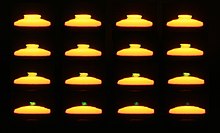
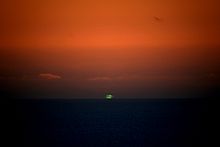
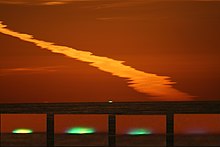
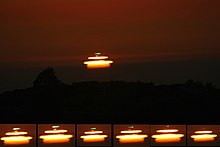
The green flash and green ray are meteorological optical phenomena that sometimes occur transiently around the moment of sunset or sunrise. When the conditions are right, a distinct green spot is briefly visible above the Sun's upper limb; the green appearance usually lasts for no more than two seconds. Rarely, the green flash can resemble a green ray shooting up from the sunset or sunrise point.
Green flashes occur because the Earth's atmosphere can cause the light from the Sun to separate, or refract, into different colors. Green flashes are a group of similar phenomena that stem from slightly different causes, and therefore, some types of green flashes are more common than others.[1]
Observing
Green flashes may be observed from any altitude. They usually are seen at an unobstructed horizon, such as over the ocean, but are possible over cloud tops and mountain tops as well. They may occur at any latitude, although at the equator, the flash rarely lasts longer than a second.[2]
The green flash also may be observed in association with the Moon and bright planets at the horizon, including Venus and Jupiter.[2][3][4] With an unrestricted view of the horizon, green flashes are regularly seen by airline pilots, particularly when flying westwards as the sunset is slowed.[2] If the atmosphere is layered,[clarification needed] the green flash may appear as a series of flashes.[2]
While observing at the Vatican Observatory in 1960, D.J.K. O'Connell produced the first color photograph of the green flash at sunset.[2]
Explanation
Green flash occurs because the atmosphere causes the light from the Sun to separate, or refract, into different frequencies. Green flashes are enhanced by mirages, which increase refraction. A green flash is more likely to be seen in stable, clear air, when more of the light from the setting sun reaches the observer without being scattered. One might expect to see a blue flash, since blue light is refracted most of all and the blue component of the sun's light is therefore the last to disappear below the horizon, but the blue is preferentially scattered out of the line of sight, and the remaining light ends up appearing green.[5]
With slight magnification, a green rim on the top of the solar disk may be seen on most clear-day sunsets, although the flash or ray effects require a stronger layering of the atmosphere and a mirage, which serves to magnify the green from a fraction of a second to a couple of seconds.[5]
While simple atmospheric refraction or lensing explains the background gradient of red-amber twilight, the primary potential cause of the bright, verdant discontinuity from that gradient known as the Green Flash may be due to naturally-occurring coherent (laser) light. Part of this phenomenon was recently discovered by researchers at the Washington University School of Medicine, regarding infrared-laser light converting-up (or upconverting) to visible-green laser light, causing what researchers there call "a double hit" of photons on the retina, creating the perception of bright neon green from an originally invisible infrared laser.[6]
Doubling the wavelength of green light yields roughly 1000-1100 nm infrared light, so the most likely hypothesis is that the Green Flash is coherent upconverted infrared (laser) light that "double-hits" the retina or camera lens, creating the effect of bright green (additionally, this explains why the Green Flash is also sometimes blue or purple; coherent infrared light can upconvert to any color of visible light if the conditions are met).
Types
The "green flash" description relates to a group of optical phenomena, some of which are listed below:[1]
| Type | Characteristics | Conditions | Best seen from |
|---|---|---|---|
| Inferior‑mirage flash | Joule's "last glimpse"; oval, flattened below; lasts 1 or 2 seconds | Surface warmer than the overlying air | Close to sea level |
| Mock‑mirage flash | Indentations seem to "pinch off" a thin, pointy strip from the upper rim of the Sun; lasts 1 or 2 seconds | Atmospheric inversion layer below eye level; surface colder than air | The higher the eye, the more likely; flash is most obvious when the eye is just above the inversion. |
| Sub‑duct flash | Large upper part of an hourglass-shaped Sun turns green for up to 15 seconds; | Observer below a strong atmospheric inversion | In a narrow height interval just below a duct (can occur at any height) |
| Green ray | Green beam of light either shooting up or seen immediately after sundown; usually a few degrees long, lasting several seconds | Hazy air and a bright green flash acting as a light source | Sea level |
The majority of flashes observed are inferior-mirage or mock-mirage effects, with the others constituting only 1% of reports. Some types not listed in the table above, such as the cloud-top flash (seen as the Sun sinks into a coastal fog, or at distant cumulus clouds), are not understood.[1]
Blue flashes
On rare occasion, the amount of blue light is sufficient to be visible as a "blue flash".[7][8]
Green rim
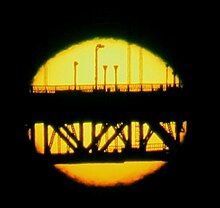

As an astronomical object sets or rises in relation to the horizon, the light it emits travels through Earth's atmosphere, which works as a prism separating the light into different colors. The color of the upper rim of an astronomical object could go from green to blue to violet depending on the decrease in concentration of pollutants as they spread throughout an increasing volume of atmosphere.[9] The lower rim of an astronomical object is always red.
A green rim is very thin and is difficult or impossible to see with the naked eye. In usual conditions, a green rim of an astronomical object gets fainter when an astronomical object is very low above the horizon because of atmospheric reddening,[10] but sometimes the conditions are right to see a green rim just above the horizon.
The following quote describes what was probably the longest observation of a green rim, which at times could have been a green flash. It was seen on and off for 35 minutes by members of the Richard Evelyn Byrd party from the Antarctic Little America exploration base in 1934:
There was a rush for the surface and as eyes turned southward, they saw a tiny but brilliant green spot where the last ray of the upper rim of the sun hung on the skyline. It lasted an appreciable length of time, several seconds at least, and no sooner disappeared than it flashed forth again. Altogether it remained on the horizon with short interruptions for thirty-five minutes.
When it disappeared momentarily it seemed to have been shut off by a tiny spurt, an inequality in the skyline caused by the barrier surface.
Even by moving the head up a few inches it would disappear and reappear again and after it had finally disappeared from view it could be recaptured by climbing up the first few steps of the antanea [sic] post.[11]
For the explorers to have seen a green rim on and off for 35 minutes, there must have been some mirage effect present.
A green rim is present at every sunset, but it is too thin to be seen with the naked eye. Often a green rim changes to a green flash and back again during the same sunset. The best time to observe a green rim is about 10 minutes before sunset.[10] That is too early to use any magnification like binoculars or a telescope to look directly at the Sun without potential harm to the eyes. (Of course, a magnified image might be projected onto a sheet of paper for safe viewing.) As the Sun gets closer to the horizon, the green rim becomes fainter due to atmospheric reddening.[10] According to the above, it is probably correct to conclude that although a green rim is present during every sunset, a green flash is rarer because of the required mirage.
In popular culture
Jules Verne's 1882 novel The Green Ray helped to popularize the green flash phenomenon.[citation needed]
In Éric Rohmer's 1986 film The Green Ray (French: Le rayon vert), the main character, Delphine, eavesdrops on a conversation about Jules Verne's novel and the significance of the green flash, eventually witnessing the phenomenon herself in the final scene.
In "Arthur's New Year's Eve" from the first season of Arthur in 1996, Arthur Read, having never stayed up until midnight on New Year's Eve before, talks with his friends about what happens when the New Year comes. Despite not actually having stayed up themselves, they each share their take on the matter, Prunella Deegan telling him that there is an amazing green flash at midnight, but if it doesn't happen, then it has to stay the same year for another whole year.[12]
Walt Disney Pictures' 2007 movie Pirates of the Caribbean: At World's End references the green flash as a signal that a soul had returned from the dead.[citation needed]
The episode Trials and Determinations! of Pokémon the Series: Sun & Moon references the green flash when Ash's Rockruff evolves into Dusk Form Lycanroc after witnessing a green flash at sunset.[citation needed]
See also
References
- ^ a b c Young, A. (2006). "Green flashes at a glance". San Diego State University page. Retrieved 5 March 2009.
- ^ a b c d e Maunder, Michael (2007). Lights in the Sky: Identifying and Understanding Astronomical and Meteorological Phenomena. Springer. pp. 72–73. ISBN 978-1846287619. Retrieved 28 September 2013.
- ^ Nave, C.R. "Red Sunset, Green Flash". Georgia State University. HyperPhysics. Retrieved 11 August 2010.
- ^ O'Connell, D.J.K. (1958). "The green flash and other low sun phenomena". Castel Gandolfo: Vatican Observatory, Ricerche Astronomiche. 4. Harvard: 7. Bibcode:1958RA......4.....O.
- ^ a b Explaining Green Flashes by Andy Young
- ^ [1] by Jim Dryden
- ^ The Green Flash, BBC Weather online. Retrieved 2009-05-07. Archived 28 August 2010 at the Wayback Machine
- ^ "Observed colors of "green" flashes".
- ^ Dispersive refraction by webexhibits.org.
- ^ a b c Green and red rims by Andrew T. Young.
- ^ Owen, Russell (23 October 1929). "Explorers see phenomenon in Pole area: Byrd party watches 'Green Flash' blaze in sky at Little America". San Francisco Chronicle. p. 5. as quoted in Young, Andrew T. "Annotated bibliography of mirages, green flashes, atmospheric refraction, etc". Retrieved 22 February 2011.
- ^ "Arthur - Holiday - New Year's Eve". PBS Kids. Retrieved 6 October 2024.
Further reading
- David Winsta "Atmospheric Refraction and the Last Rays of the Setting Sun", reported at the Manchester Literary & Philosophical Society Meeting, 7 October 1873
- Sir Arthur Schuster, Letter to NATURE, 21 February 1915, referring to his observation of the phenomenon on a voyage in the Indian Ocean in 1875
- Captain Alfred Carpenter & Captain D. Wilson-Barker, Nature Notes for Ocean Voyagers (London, 1915), reported on page 147
External links
- A Green Flash Page, Andrew T. Young's page with comprehensive explanations and simulations
- Green Flash – Atmospheric Optics, explanations and image gallery, Les Cowley's Atmospheric Optics site
- NASA Astronomy Picture of the Day: A Green Flash (21 March 2004)
- 06/03/2010 Photograph of a green flash over the Indian Ocean
- Green Flash Videos
